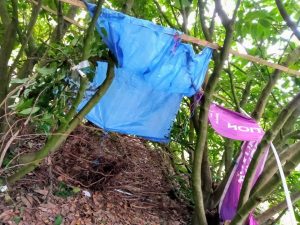As part of the Situated Communication course we ventured outside and tried our hands at den building. Most of our dens would probably not have sheltered us with a great degree of success. Thankfully the purpose of this endeavour was … Continue reading →
As part of the Situated Communication course we ventured outside and tried our hands at den building. Most of our dens would probably not have sheltered us with a great degree of success. Thankfully the purpose of this endeavour was more to do with metaphorical building rather than literal, building ourselves into cohesive teams who could communicate with one another rather than structural integrity.
Group Leadership
We were assigned groups based on our birth months, this made it more likely for us to work with people we previously hadn’t. In this newly created group we began to establish a group dynamic. No one put themselves forward as leader initially and this continued throughout the project. Decisions were made collaboratively, not with a formal vote but by people putting forward suggestions of where to place items or how to attached various structures. Most people contributed through questions “What if we put the tarpaulin here?” or “Do some of us want to go a get some more sticks?” which lead clarifications “You mean like this?”. If there was a disagreement it would always be followed by a explanation which I hope meant that no felt excluded or that their ideas where not appreciated. We also joked and while we took the task seriously we were not overly competitive which lead to a relaxed atmosphere within the group.
There were two parts of this activity that I personally felt were challenging. Firstly I am aware that I can be a dominating character in a group situation and tried to make sure that I was listening more than I was talking. I think I was successful though I consider it an ongoing goal.
Secondly I struggled to use positional language. We needed to guide poles through tree branches for the roof of our den. This required one person to manoeuvre the pole from in the tree and one person on the ground to direct them. I kept saying “move the thingy a bit this way” coupled with hand gestures rather than the more clearer “move the stick a bit to the left”. This was particularly unhelpful when directing a team member who cant see you! This is a clear area of development for me which I will work on going forward.
Explaining
The group explanation was well done following a logical and chronological format. There was one spokesperson from the group which ensured clarity and that a common understanding could be reached.
Environment
We were lucky in that the environment was not overly noisy and the nature of the assignment and our enclosed location in the trees meant that we were physically very close to each other. When it came to explaining our den to the other groups we have to be more mindful of where we stood and that we were facing the group face on.
Although it was fairly quiet being outside is a more stimulating experience than in our usual sterile classrooms or lecture theatre. I found that my attention wandered somewhat or that I would be hyper focus on a manual task which meant that I didn’t listen as well as I could have. If there was a word to call the full attention of the whole group for examples “Guys, what if ..” or if someone called my name I would be engaged more readily. In a teaching situation I would also use children’s names, if possible be in the same location or use a bell or other unique sound to call the attention and gather groups before speaking.
Negotiation
We were wholly unsuccessful in task to ask another group for part of their den which seemed essential to it’s construction. However the negotiation itself was carried out in a friendly manner and each group’s reasoning was well thought out. The most challenging aspect was having to continually say no to people and to also continually approach people asking for something which would effectively ruin their work.


